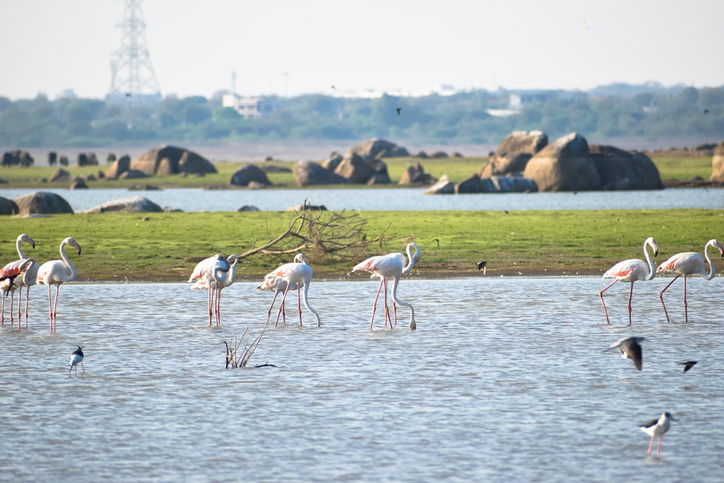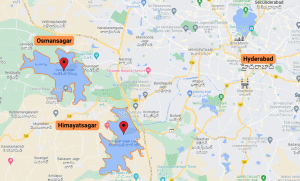
Hyderabad faces 3 disastrous consequences with scrapping of GO 111

The issue goes back to 1908, when Hyderabad was devastated by a flood. The Nizam requested Sir Mokshagundam Viswesvaraya to study the calamity and suggest measures to avoid future flooding of the city. Based on Viswesvaraya’s recommendation, two reservoirs — Osman Sagar and Himayat Sagar — were constructed.

In 1996, the government of erstwhile Andhra Pradesh issued GO 111 to protect the catchment areas of the two lakes. More than 1 lakh acres of land were brought under the purview of the GO across several villages. The aim was to curb construction and industrial activity in the catchment area of the two lakes up to a radius of 10 km to preserve the water quality and environment. The two reservoirs were the only sources of drinking water for Hyderabad-Secunderabad till 2000, when water began to be drawn from River Krishna.
Also read: How Reddys, Kammas, Velamas made it to Hyderabad billionaires’ list
In April 2022, the Telangana government led by K Chandrashekar Rao issued GO 69 that scrapped the restrictions imposed by GO 111. In May 2023, it scrapped GO 111 altogether, even while a report by an expert committee on the protection of the two reservoirs was pending. (The National Green Tribunal, or NGT, had asked the state government to form a committee of three members to study GO 111 and the feasibility of its cancellation.)
Scope of GO 111
GO 111 was applicable to 84 villages and 7 mandals, totalling 1.32 lakh acres. Around 200 sq km of land fell under the catchment area, as stipulated by the GO. Around 84 per cent of the landholdings belong to small and marginal farmers, who were receiving their subsistence from agriculture.
The 84 villages are from seven mandals — Shamshabad (35), Shabad (2), Shankarpally (3), Rajendranagar (5), Chevella (6), Moinabad (32), and Kothur (1) — that hold huge real estate potential given their proximity to IT corridors.
The absence of logic behind repealing GO 111 and bringing in GO 69 — effected to release huge land parcels for real estate sharks in the catchment area — is going to have three major consequences for Telangana and its people.
Displacement of locals
The move will be hugely detrimental to the locals, as they will lose their agricultural lands to realtors. They will end up transferring their land and becoming migrants and travelling to other places in search of livelihoods. The cash they receive in land sale would get diminished, and they would not be able to find land elsewhere with the proceeds.
Small and marginal farmers will be displaced, losing fertile, cultivable lands. The money accrued would not be enough to provide security. Social relationships and networks may go for a toss as the locals would move out of their homeland.
The Federal Premium | The Kolkata wetlands trail: The beauty and neglect a solo traveller found on the way
The nexus between politicians, realtors and builders has led to the cancellation of GO 111, which will have a disastrous effect on the local people’s ownership of the lands. As a result, local people without any major skills to earn livelihoods will find it difficult to sustain themselves and lead a dignified life.
The water drawn through gravity from the twin water bodies for drinking purposes is economical, especially since it is in the vicinity (less than 20 km). On the other hand, drawing water from the Godavari and the Krishna is quite expensive given the huge infrastructure and its maintenance.
If we weigh the implications of the Telangana government’s move to cancel the GO 111, it is certainly a kind of displacement rather than development, as around 3 lakh families are going to be dislocated and some may fall into poverty.
Impact on ecology, environment
Secondly, the flora and fauna in the bio-conservation zone are at risk, posing a threat to the rich biodiversity in this area. Floods from the river up-stream during the rainy season were diverted to the two reservoirs earlier. Now, because of growing concretisation, the course of floods may change and it poses a massive risk to Hyderabad city. GO 69 does not mention anything about the flood control aspect of the reservoirs, which is a matter of serious concern.
The Federal Premium: How Hyderabad’s Open House run by a doctor couple is healing hunger pangs
Besides, the water from Ananthagiri hills, which is at present flowing into these two water bodies, will be disturbed in the future. Ecological balance and environment in this area will be affected with the upcoming construction projects and concrete jungle, encroachments and pollution, while the people of 84 villages who are agriculture-dependent will be left in the lurch.
A visit to the area by this writer revealed that the ‘process of land alienation’ began well before the scrapping of GO 111, due to the announcements made by the state government earlier that the GO was ‘redundant’. So, in effect, many small and marginal farmers have already sold their land, fascinated by lucrative prices offered by profit-making realtors.
It’s being said that some land parcels have been purchased under benami names at a cheaper price, giving scope to speculation that land prices will go up in the coming months. Some locals regret having sold their lands already.
Added to this, some local people reported that they were offered ₹1-2 crores per acre, which they thought was big money four years back. Now, the land prices have shot up to ₹10-20 crore per acre and others predict that it would rise to the level of ₹50-80 crore in the next few years.
Also read: Kadapa steel plant: Why Naidu, Jagan keep it alive though it is not feasible
The underlying logic of price increase is that the politicians purchased land in the area, followed by realtors, and spread the news that GO 111 would be cancelled later. The entire phenomenon led to ‘artificial growth of land markets’.
Increase in inequalities
The development of Madhapur and Gachibowli areas due to software companies has made Hyderabad seem ‘two’ different cities. One part is characterised by software professionals, realtors and builders, while the other one is a city of middle-class people.
The former is identified by good, broad roads with green traffic islands, cycling tracks with solar power and flashy buildings, while the rest of the city struggles for basic civic amenities like proper drainage and pedestrian walkways. It appears that the discriminatory attitude of the administration makes it indifferent to providing amenities to the existing city and people, while sanctioning facilities overnight to the ‘new’ city.
The lifting of GO 111 will further aggravate the economic inequalities in the city of Hyderabad. Upcoming areas like Narsingi, Kokapet, Neopolis, Mokila and Shankarpally, among others, will become neo-rich areas, while other parts of the city will again be left behind.
Needed: Status quo
The government should revert the repeal of GO 111, and ensure status quo in order to maintain the ecological balance. It will also allow the locals to retain their land and livelihoods. If this is done, it will go a long way in protecting the interests of lower middle-class people and paving the way for the natural — not artificial — development of the city.
(The writer is a former Consultant-Economist with UN Women (New Delhi) and UNICEF (Indonesia). At present, he is the CEO of the Satavahana Development Society, Hyderabad.)
(The Federal seeks to present views and opinions from all sides of the spectrum. The information, ideas or opinions in the articles are of the author and do not necessarily reflect the views of The Federal)


